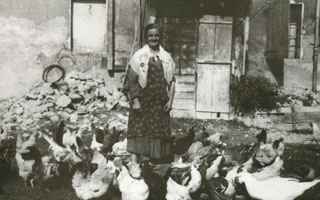The henhouse and chicken raising

The female heads of house, le reggitrici, raised chickens, guinea fowl, turkeys and geese for family use and for sale at market. Although sharecropping contracts specified that landowners were to receive eggs and animals from the tenant farmers, the landowners considered this compensation to be inferior to the damage they inflicted on the farm and thus tried to limit the number of birds raised. Chickens would graze not only on the grass and among the wheat stubble, but also in the seeded fields. In the evenings, the fowl were fed some birdseed in the courtyard prior to settling in the henhouse or perching for the night on nearby tree branches.
In practice, le reggitrici kept as many birds as they liked and each farm would raise up to 200 animals per year including: hens (galénna), chicks (pipién), pullets (pulaster), capons (capòn), guinea-fowl (faraónna), turkeys (tòch, tuchén), etc. Roughly 30 laying hens produced an average of 100 eggs each per year, ranging from a minimum of two during the month of January to a maximum of 14 in May. The reggitrice was able to recognize the laying hens and would prepare the nests using a fake egg (èng’). She would then gather the eggs for family use, take them to market or preserve them in lime water for the winter. Otherwise, she would select eggs and mother hens and prepare the nests for brooding, checking against the light that the eggs had been fertilized. After chicks hatched, she cared for them, feeding and fattening them to either sell the pullets or castrate them as capons.